This entry includes a walking tour! Take the tour.
Introduction
Text-to-speech Audio
Growing from humble beginnings in a one-room schoolhouse in 1964 to the sprawling, park-like atmosphere and 40+ buildings of today, the Pioneer Village Museum is a volunteer-driven endeavor by the Barron County Historical Society to provide the best in cultural understanding about the history of Northwestern Wisconsin. Historic homes and buildings line the classic “Pioneer Village,” while multiple outlying display buildings enhance the story of the region with displays from homes, businesses, farms, libraries, and more. This museum encourages exploration and includes abundant green areas for picnic lunches and resting outdoors while visiting the grounds.
Images
Visitors touring the Pioneer Village during the 2020 season
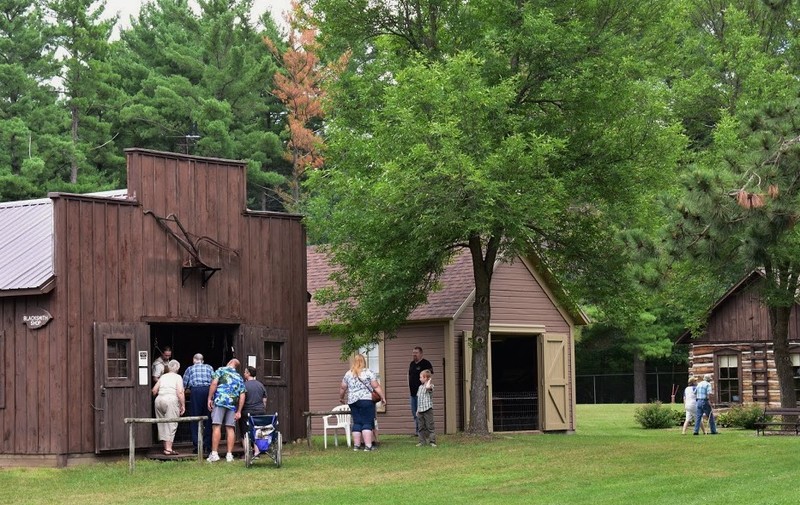
The Barron County Historical Society's 1968 Board Members stand in front of the original Pioneer Village Museum - the Joliet School and first pole building. Pictured from left to right are Clarence Seidle, Myrtise Seidle, Andy Helland, Kay Antenne, and Betty Christianson. This photo would have been taken prior to August 1968; Board President, Clarence Seidle, passed away in August that year and Vice President Andy Helland filled out the rest of his term through December.
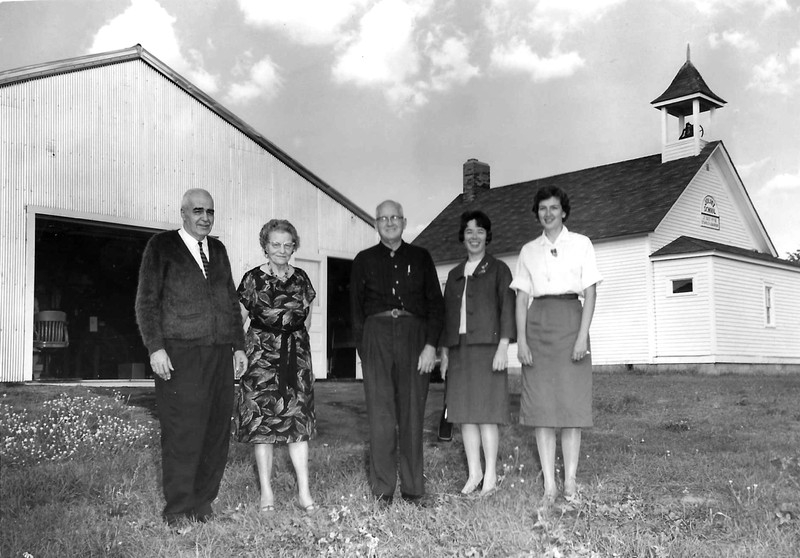
Mr. Lundgren, of Barron, examines a student's display during the 1968 Junior Historian competition at Woodland School in Barron, Wisconsin. The Barron County Historical Society aided in organizing and hosting this event.
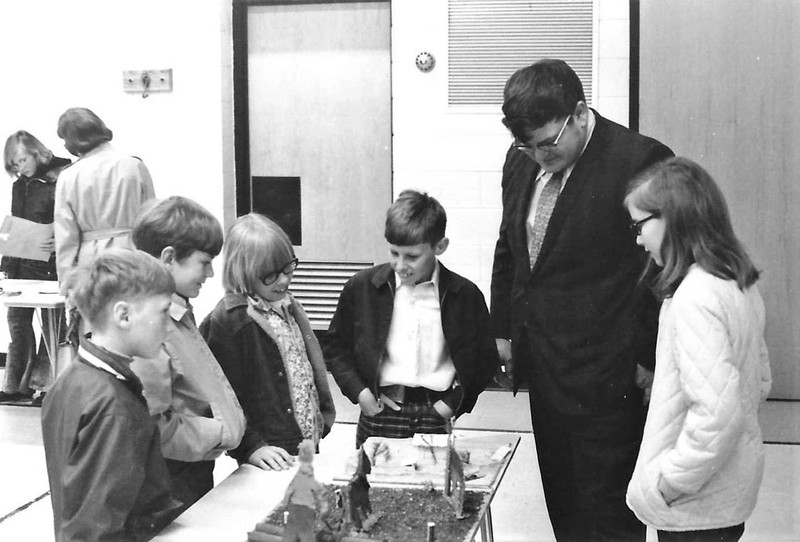
Past Reflections Classic Car Show 2018, held annually on the grounds of the Pioneer Village Museum
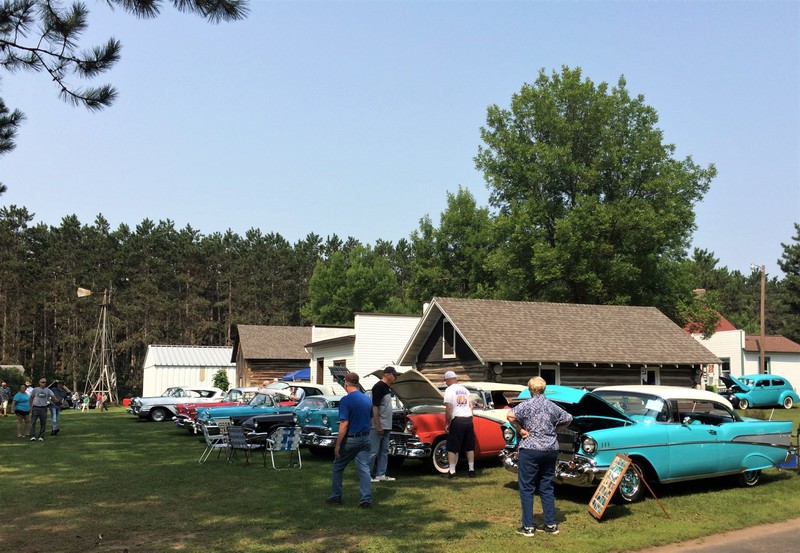
Vintage Baseball 2018, held annually on the grounds of the Pioneer Village Museum
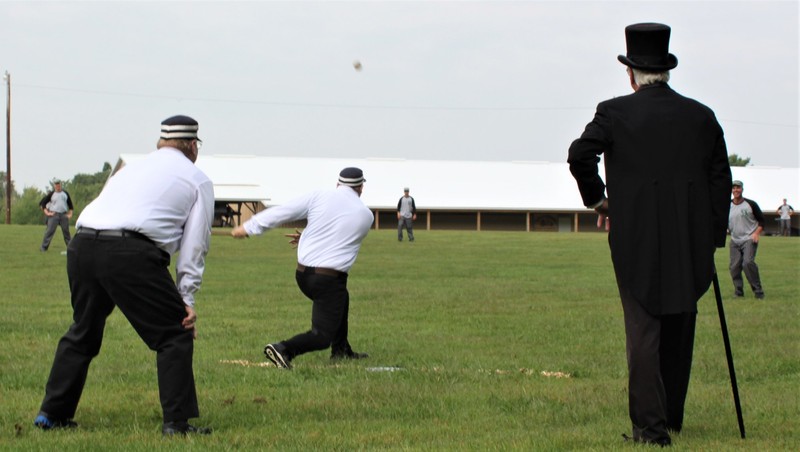
Volunteer demonstrating traditional painting skills to her daughter during Heritage Days 2018
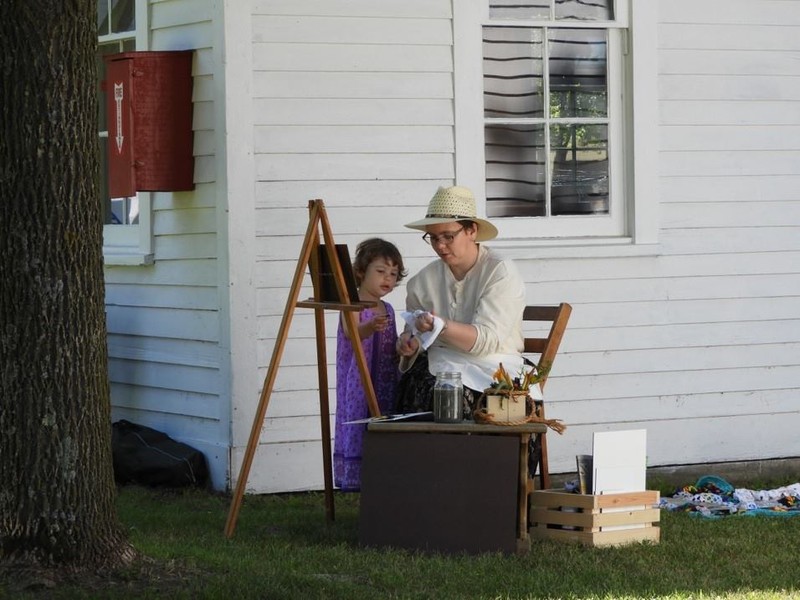
Area school students watch traditional Ojibwe drummers during school tours, 2019. Each year, students from elementary and middle schools across northern Wisconsin visit the Pioneer Village Museum as part of their coursework in learning Wisconsin and local history. This gives students an opportunity for immersive, multi-sensory learning outside the classroom.

Volunteers (sisters) making butter in a traditional-style home, July 2020. The COVID-19 pandemic provided some challenges to the Pioneer Village Museum during 2020, but with many volunteers working together as families, some of the challenges were able to be overcome.
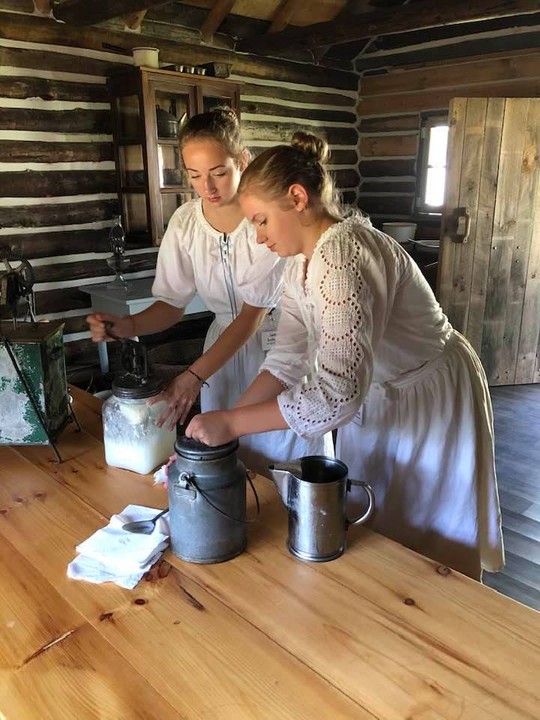
Backstory and Context
Text-to-speech Audio
Long before the creation of the Barron County Historical Society, and even before a selection of Barron County acreage was carved out to become the Barron County Game Farm, vast stands of pine stood across the region, especially the abundant and much-sought white pine. As lumber barons flocked to the area from the Eastern United States to carve out their fortune in virgin timber, and railroads laid new track to help them carry new employees and goods to their logging sites, they passed through the property where the Pioneer Village Museum today stands, building communities at Cameron and Barron, and utilizing the Red Cedar River. Today, the Red Cedar River bubbles quietly near the west side of the Pioneer Village Museum, and tall pines frame the village, standing as towering reminders of what brought the white pioneers to Barron County in the first place. It is on these 40 acres, in 1964, a one-room schoolhouse was first set down and started the humble beginnings of a thriving cultural and historical museum.
This museum was the brainchild of a group of women who belonged to the local Fortnightly Club. One night in August 1958, this group met in the home of Mildred Johnston, with Johnston, then president of the Club, leading discussion for new ideas. When Jean Mellblom suggested Barron County was lacking a historical society and that the Fortnightly Club women could create one, many of the other women readily voiced support. Mellblom’s husband soon transferred to a different city for work, so she was unable to see her idea brought to fruition, but the idea had taken hold among the Fortnightly Club, and several others kept it alive and going. The idea spread, and soon a group of women from a federation of women’s clubs across Barron County were working on the project.
The first committee to begin work on the fledgling historical society was chaired by Fortnightly Club President Mildred Johnston of Rice Lake; the other members of the committee included Cumberland representatives Edna King, Vernice “Verny” Weimar, and Cathrine Wickre; Barron representatives June Rockman and Blanche Morrison; and Rice Lake representatives Katharine “Kay” Antenne and Margaret “Peg” Haugen. These women worked together with members of the local community and the state historical society to establish and found the Barron County Historical Society, Inc, which was released in March 1960 from the federated women’s clubs into its own society with Mildred Johnston elected as its first President. Kay Antenne was elected Vice President and June Rockman was elected Secretary-Treasurer. This first meeting was a resounding success with 23 members in attendance, by-laws approved by the newly-founded membership, and dues established at $1.00 per person per year.
In less than a year, the Historical Society knew they needed a permanent site for a museum and had started to pursue the idea of putting a retired schoolhouse on the site of the Barron County Game Farm. While this plan was in development, they also moved forward with establishing the first Junior Historian Program for Barron County, chaired by Betty Christianson of Barron, which grew to receive a Certificate of Commendation from the State Historical Society in 1965 for a very fine program. These projects, in addition to regular meetings with history-related speakers, kept the Historical Society busy and active. By 1964, through a donation from the school districts of Barron, Cameron, and Rice Lake, the Joliet School was established as the home of the Barron County Historical Society on the Barron County Game Farm; two years later, in 1966, a 30x32 pole building was built next to the school house to house the already-expanding collection of the fledgling museum, and the Pioneer Village Museum was off and running. Today, the site encompasses over 40 buildings on acres of park-like grounds enclosed in towering Wisconsin pines, continuing to grow and tell the story of Northwestern Wisconsin’s rich history.
In 60 years, the Pioneer Village Museum has grown a legacy that reaches individuals, communities, and the future. Through nurturing personal and collective identity and helping people discover their stories, developing contextual understanding, and creating the foundation for strong Barron County communities, the museum has taken seriously its role as a cultural heritage institution. In this, the museum also seeks to help people envision a better future; these engaged citizens volunteering at and visiting the Pioneer Village Museum attract talent, increase tourism revenues, and fortify the local economies. Most importantly, it inspires our leaders - seeing history tied to people and the local community inside the Pioneer Village Museum provides role models for current leaders navigating modern life and helps up and coming leaders clarify their values and ideals.
The Pioneer Village Museum continues to grow and thrive every day through the hard work and dedication of a small paid staff and a large pool of volunteers who maintain the grounds and buildings, curate displays, guide tours, and create new and interesting events and programs for visitors each year. The buildings preserve artifacts, but the people who work in and around them preserve the memories and stories of the history of Northwestern Wisconsin for the future.
Sources
Jensen, Clarice. Kettner, Carol. Barron County Historical Society and Pioneer Museum History. Edition 2. Volume 1. Cameron, WI. Unpublished - Binder Bound in Museum Archives, 2018.
Staff. Value of History, Pioneer Village Museum. May 1st 2020. Accessed July 26th 2020. https://www.pioneervillagemuseum.org/value-of-history.
Pioneer Village Museum photo album archives
Pioneer Village Museum photo album archives
Pioneer Village Museum digital photo archives
Pioneer Village Museum digital photo archives
Pioneer Village Museum digital photo archives
Pioneer Village Museum digital photo archives
Pioneer Village Museum digital photo archives
